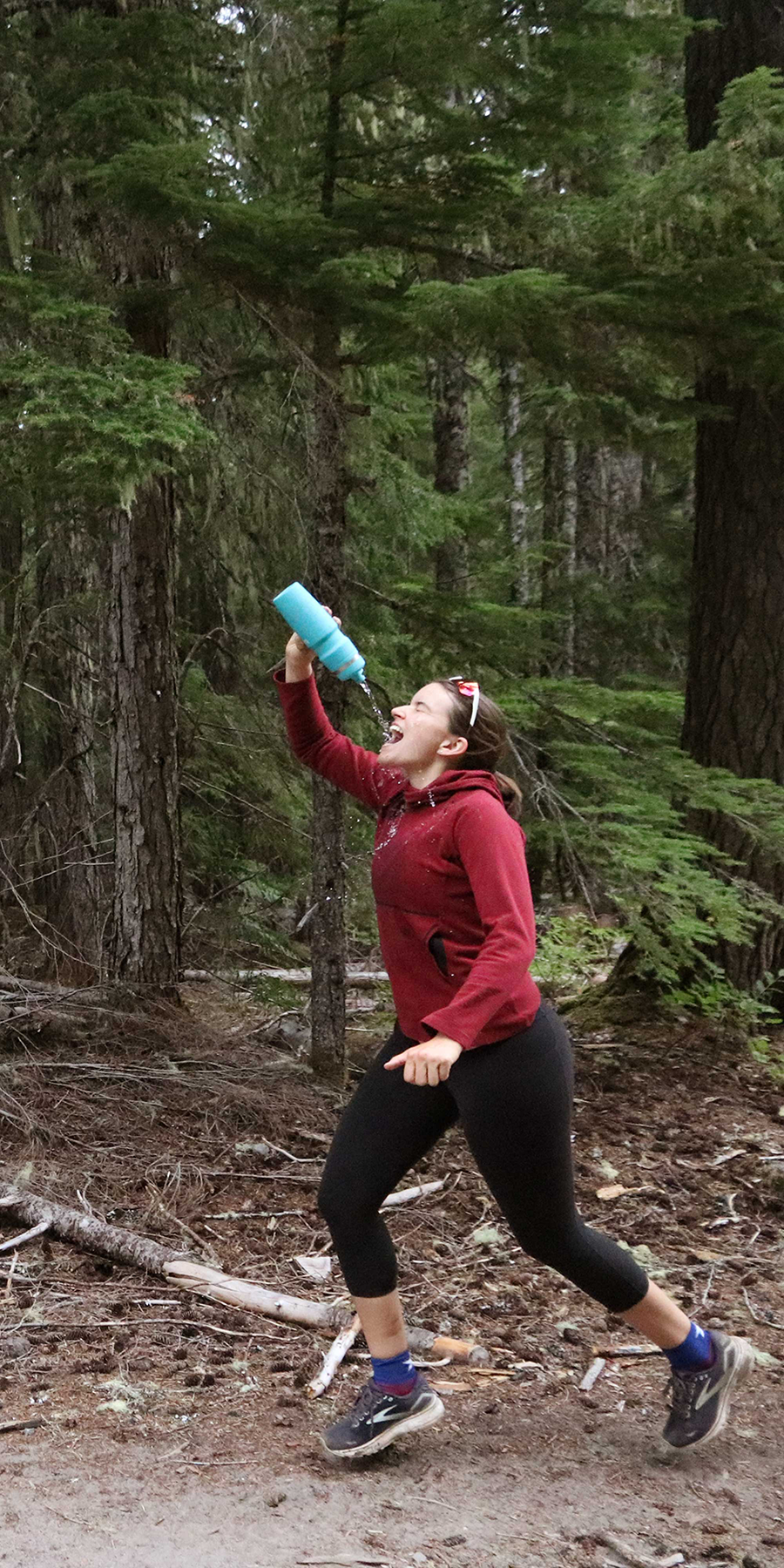January 9th, 2025 | By Keaton Smith
Kim Lord is the owner of Front Runner Athletic Medicine, a sports medicine clinic in Williston, VT. With a Bachelor’s degree in Athletic Training/Nutrition/Exercise Science from University of Vermont, Kim is now a certified athletic trainer and RRCA certified running coach. Her business specializes in the care, prevention and rehabilitation of injuries. Her business also provides Nutrition and Running Consultations.
Kim has competed in 48 marathons throughout her career, along with many other races at varying distances. Vice President of the Green Mountain Athletic Association (a local Vermont running club), expo director for the one of the largest marathons in New England, the Vermont City Marathon organized by RunVermont, and the director of local races, Kim is truly a run expert!
Kim Lord is the owner of Front Runner Athletic Medicine, a sports medicine clinic in Williston, VT. With a Bachelor’s degree in Athletic Training/Nutrition/Exercise Science from University of Vermont, Kim is now a certified athletic trainer and RRCA certified running coach. Her business specializes in the care, prevention and rehabilitation of injuries. Her business also provides Nutrition and Running Consultations.
Kim has competed in 48 marathons throughout her career, along with many other races at varying distances. Vice President of the Green Mountain Athletic Association (a local Vermont running club), expo director for the one of the largest marathons in New England, the Vermont City Marathon organized by RunVermont, and the director of local races, Kim is truly a run expert!
Kim after completing the 2022 New York City Marathon.
Kim after completing the 2022 New York City Marathon.
Kim: Consider running on the treadmill, using the elliptical, or swimming to keep up fitness in the off season. Generally, you should cross train as often as you would ride. For example, if you ride 5 days/week, you should aim to cross train 5 days/week. This could be: 1-2x per week on the indoor trainer/swimming, 2-5x per week treadmill or trails.
Finding the right mix for you depends on how long your off season is as well as your own body and schedule.
Kim: Aim for strength training 2-3x/week. Cyclists are quad dominant, so in the off season, try to improve strength in the glutes, hamstrings, low back and abductors/adductors. Work on explosive movements such as jumping or lunging.
Plus, core is extremely important. Strengthen lower abdominals with leg lifts, planks, and medicine ball twists.
Kim: Yes!
On-season: since you’re already working the large muscle groups when you’re on the bike, when off the bike and cross training, focus on strengthening intrinsic, stabilizer muscles. Stabilizer muscles are your smaller muscles that keep you sharp.
Off-season: Focus on larger muscle groups. Work on strengthening muscles that you don’t work on the bike: Glutes, hamstrings, and aim to improve lateral movements and strength.
Kim: Cycling isn’t weight bearing and doesn’t create a lot of impact on bones and joints. Weight bearing exercises are good for bone density, so they are something that cyclists should work on in the off season and in general.
To build stronger bones, you want to practice impact (carefully). If your body isn’t used to impact, there is a chance for injury, so be careful how quickly you incorporate weight bearing exercises if you’re not used to them.
For women, especially, it is beneficial to add in these weight bearing exercises for bone strength and density.
For example, walking puts 2-3x of your body weight on your joints, while running puts 10x body weight on your joints. While they are great exercises for improving bone density, it’s also important to begin running and other weight bearing exercises carefully to avoid injuries.
Kim: Consider running on the treadmill, using the elliptical, or swimming to keep up fitness in the off season. Generally, you should cross train as often as you would ride. For example, if you ride 5 days/week, you should aim to cross train 5 days/week. This could be: 1-2x per week on the indoor trainer/swimming, 2-5x per week treadmill or trails.
Finding the right mix for you depends on how long your off season is as well as your own body and schedule.
Kim: Aim for strength training 2-3x/week. Cyclists are quad dominant, so in the off season, try to improve strength in the glutes, hamstrings, low back and abductors/adductors. Work on explosive movements such as jumping or lunging.
Plus, core is extremely important. Strengthen lower abdominals with leg lifts, planks, and medicine ball twists.
Kim: Yes!
On-season: since you’re already working the large muscle groups when you’re on the bike, when off the bike and cross training, focus on strengthening intrinsic, stabilizer muscles. Stabilizer muscles are your smaller muscles that keep you sharp.
Off-season: Focus on larger muscle groups. Work on strengthening muscles that you don’t work on the bike: Glutes, hamstrings, and aim to improve lateral movements and strength.
Kim: Cycling isn’t weight bearing and doesn’t create a lot of impact on bones and joints. Weight bearing exercises are good for bone density, so they are something that cyclists should work on in the off season and in general.
To build stronger bones, you want to practice impact (carefully). If your body isn’t used to impact, there is a chance for injury, so be careful how quickly you incorporate weight bearing exercises if you’re not used to them.
For women, especially, it is beneficial to add in these weight bearing exercises for bone strength and density.
For example, walking puts 2-3x of your body weight on your joints, while running puts 10x body weight on your joints. While they are great exercises for improving bone density, it’s also important to begin running and other weight bearing exercises carefully to avoid injuries.
Kim: YES! Running is a great cross-trainer due to its impact, BUT you must be careful how quickly you increase mileage and the surface.
Running is great for strengthening musculature that isn’t used as much during cycling. It’s also a fantastic cardio builder. It helps with endurance and it really just breaks up the monotony of other activities.
Kim: Get a good pair of running shoes.
Consult with your local running store or REI. Try to use your running shoes exclusively for running as the wear pattern is different for running and other activities. Replace your shoes every 350-400 miles or, ideally, every 6 months.
Start with a mixture of running and walking.
Begin with a 5 minute walk then a 1 minute jog. The next day, if you’re not sore, you can move to a 4 min walk and 2 minute jog, then 3 and 3 etc. Once you reach a 5 minute jog and 1 minute walk, you can try running for 10 minutes and increase the time by 5 minutes every other day after that. If sore after any of the days, repeat the same day’s exercises until not sore.
Use the 1:3 ratio.When you’re ready for longer runs and want to determine how many miles you should be running, you can use the 1:3 ratio. For every 3 miles you’d ride on the bike, run 1 mile to get similar benefits.
Kim: Benefits: cardio, impact, and bone density. Running is great for your mental health, as a stress relief and as a social activity.
Drawbacks (if you don’t progress the right way): could create stress related injuries due to increase in impact on bones, tendons, & muscles.
Kim: YES! Running is a great cross-trainer due to its impact, BUT you must be careful how quickly you increase mileage and the surface.
Running is great for strengthening musculature that isn’t used as much during cycling. It’s also a fantastic cardio builder. It helps with endurance and it really just breaks up the monotony of other activities.
Kim: Get a good pair of running shoes.
Consult with your local running store or REI. Try to use your running shoes exclusively for running as the wear pattern is different for running and other activities. Replace your shoes every 350-400 miles or, ideally, every 6 months.
Start with a mixture of running and walking.
Begin with a 5 minute walk then a 1 minute jog. The next day, if you’re not sore, you can move to a 4 min walk and 2 minute jog, then 3 and 3 etc. Once you reach a 5 minute jog and 1 minute walk, you can try running for 10 minutes and increase the time by 5 minutes every other day after that. If sore after any of the days, repeat the same day’s exercises until not sore.
Use the 1:3 ratio.When you’re ready for longer runs and want to determine how many miles you should be running, you can use the 1:3 ratio. For every 3 miles you’d ride on the bike, run 1 mile to get similar benefits.
Kim: Benefits: cardio, impact, and bone density. Running is great for your mental health, as a stress relief and as a social activity.
Drawbacks (if you don’t progress the right way): could create stress related injuries due to increase in impact on bones, tendons, & muscles.
Kim loves running on the bike ferry causeway from her house in South Hero, Vermont or finding a stretch for a long run anywhere on the Vermont rail trail.
Join Bivo in person in our monthly run clubs! We're taking off from Bivo HQ (in Richmond) tomorrow (Jan 10th) at 7am!
RSVP here: Bivo Run Club on Strava
Need a recommendation on the best running water bottle? We can help!
Kim loves running on the bike ferry causeway from her house in South Hero, Vermont or finding a stretch for a long run anywhere on the Vermont rail trail.
Join Bivo in person in our monthly run clubs! We're taking off from Bivo HQ (in Richmond) tomorrow (Jan 10th) at 7am!
RSVP here: Bivo Run Club on Strava
Need a recommendation on the best running water bottle? We can help!
Rather keep fitness up on the bike indoors? We love indoor spin classes (shoutout Burlington YMCA + Align Cycling in Williston!)
Rather keep fitness up on the bike indoors? We love indoor spin classes (shoutout Burlington YMCA + Align Cycling in Williston!)


Leave a comment (all fields required)